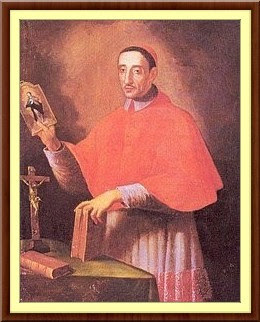⛪ Memorial:
• 1 January • 3 January (Theatines)
⛪ Other Names:
• Giuseppe Maria Tomasi di Lampedusa • Giuseppe Maria Tomasi • Guiseppe Maria Tommasi • Josef Maria Tomasi • Joseph Marie Carus • Joseph Mary Tommasi • José María Tomasi
• 1 January • 3 January (Theatines)
⛪ Other Names:
• Giuseppe Maria Tomasi di Lampedusa • Giuseppe Maria Tomasi • Guiseppe Maria Tommasi • Josef Maria Tomasi • Joseph Marie Carus • Joseph Mary Tommasi • José María Tomasi
• Born: 12 September 1649
• Died: 1 January 1713 (aged 63)
• Patronage: Catholic liturgy
• Major Shrines: Basilica of Sant'Andrea della Valle, Rome, Italy
A Cardinal, noted for his learning, humility, and zeal for reform; born at Licata, Sicily, of a princely family, on 12 September 1649; died in Rome, 1 January 1713. Though destined by his father for the Spanish Court, he joined the Clerks Regular of the Theatine Order at Palermo, on 24 March 1665, renouncing his primogeniture and the princedom in favour of his brother. He was professed on 25 March 1666. He studied philosophy, first at Messina, and later, owing to poor health, at Ferrara and Modena; and theology in Rome and Palermo. He was ordained priest on Christmas Day, 1673. To a wide knowledge of Greek, he united the study of Ethiopic, Arabic, Syriac, Chaldaic, and Hebrew–converting his master a Jewish rabbi, to Christianity. From the Psalters in these different languages, he collected the titles of the Psalms. He devoted himself to the study of Scripture and the Fathers. Searching the chief libraries, archives, and monuments, he retraced the ancient ecclesiastical discipline and liturgy.
His valuable works (Codici Tommasiani), published chiefly from ancient codices in the Vatican and Vallicellian Libraries and the Library of Christina of Sweden, were highly praised by the different academies of Europe, even Protestant. Chief among his publications is the “Codices sacramentorum nongentis annis antiquiores” (Rome, 1680), partly transcribed by Mabillon in his “Liturgia Gallicana”. Following these, in order of time, was: “Psalterium” (Rouse, 1683), according to the Roman and Gallican editions, published under the name of Giuseppe Maria Caro”. In this work Tommasi introduced Origen’s symbols (obeli and asterisks), obsolete for nine centuries. Under the same pen-name Tommasi wrote, “Responsalia et Antiphonaria Rom. Eccl.”, etc (Rome, 1686); “Sacrorum Bibliorum Tituli, sive capitula” (Rome, 1688); Antiqui libri Missarum Rom. Eccl.” or the Antiphonary of Pope Saint Gregory, entitled “Comes”, written by Alcuin at the order of Charlemagae (Rome, 1691); “Officium Domicinae Passionis”, used by the Greeks on Good Friday, translated into Latin (Rome, 1695). Under his proper name he published “Speculum” (Rome, 1679); “Exercitium Fidei, Spei et Caritatis” (Rome, 1683); “Breviarium psalterii (Rome, 1683); “Vera norma di glorificar Dio” (Rome, 1687); “Fermentum” (Rome, 1688); “Psalterium cum canticis” (Rome, 1697); “Indiculus institutionum theologicarum veterurn Patrum” (3 vols., Rome, 1709, 1710; 1712), an exposition of theological theory and practice, derived from original patristic sources. Tommasi also wrote numerous opuscula, the last four published by G. Mercati (Rome, 1905). In 1753 Vezzosi published his works in eleven quarto volumes.
Tommasi’s efforts at reform were directed not to the introduction of the new, but to the restoration and maintenance of the old. He was not always upheld and was sometimes rebuked for his zeal. Innocent XII made him examiner of the bishops or of the clergy. Clement XI appointed him consultor of the Theatine Order, theologian of the “Congregatio super Disciplinâ Regulari” and other Congregations, consultor of the Congregations of Rites and Indulgences, and qualificator of the Holy Office. The same pope created him cardinal-priest of the Title of S. Martino ai Monti and compelled him to accept the honor. Taking Saint Charles Borromeo as his model, Tommasi practiced humility and charity towards the poor. He taught catechism to the children of the poor in his titular church. He introduced the use of Gregorian chant in his church. On his death, he was mourned by all, even by the pope, who so admired his sanctity that he consulted him before accepting the papacy. He was beatified by Pius VII, on 5 June 1803. Every year the Arcadians hold a religious and literary commemoration in his honour. His body rests in the church of S. Martino ai Monti.









%20Virgin%20and%20Martyr.jpeg)
No comments:
Post a Comment